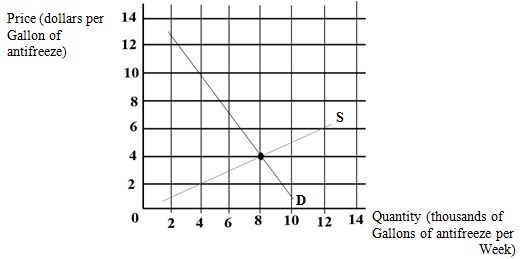Problem 1:

The figure above illustrates the market for antifreeze. Suppose the government decides to implement an $8 sales tax on every gallon of antifreeze sold.
A. In the figure, how would I illustrate the effect that the tax has on the market for antifreeze?
B. How do I find out and what is the equilibrium price of a gallon of antifreeze before the tax? What is the price paid by buyers after that tax?
C. What would be the equilibrium quantity of antifreeze be before and after the tax?
D. What is the revenue collected by the government from this tax?
E. In this case, would the buyers or sellers bear the largest burden of the tax?
F. How would I illustrate the deadweight loss created by the tax?
Problem 2: Jason wants to hire Maria to tutor him in economics. Jason is willing to pay $30 for the first hour of tutoring, $25 for the second, $20 for the third, $15 for the fourth, and $10 for the fifth. Maria has an opportunity cost per hour of $6 for the first, $9 for the second, $12 for the third, $15 for the fourth, and $18 for the fifth. The initial equilibrium price for tutoring is $15 an hour and hence Maria tutors Jason for 4 hours. Now, Maria realizes that she is the only economics tutor because all the other tutors have graduated. Because she is the only tutor, she has a monopoly and, as a monopolist, Maria decides to charge a price of $25 instead of $15 an hour.
A. At the price of $25 an hour, how many hours will Maria tutor Jason?
B. At the initial equilibrium price of $15 an hour, what was Jason’s total consumer surplus and Maria’s total producer surplus?
C. At the price of $25 an hour, what is Jason’s total consumer surplus and what is Maria’s total producer surplus?
D. How does the sum of Jason’s consumer surplus plus Maria’s producer surplus compare at the initial equilibrium price of $15 an hour (part b) and at the new price of $25 an hour (part c)? Comment on any difference.